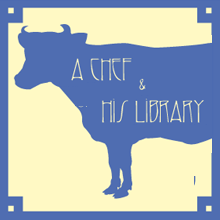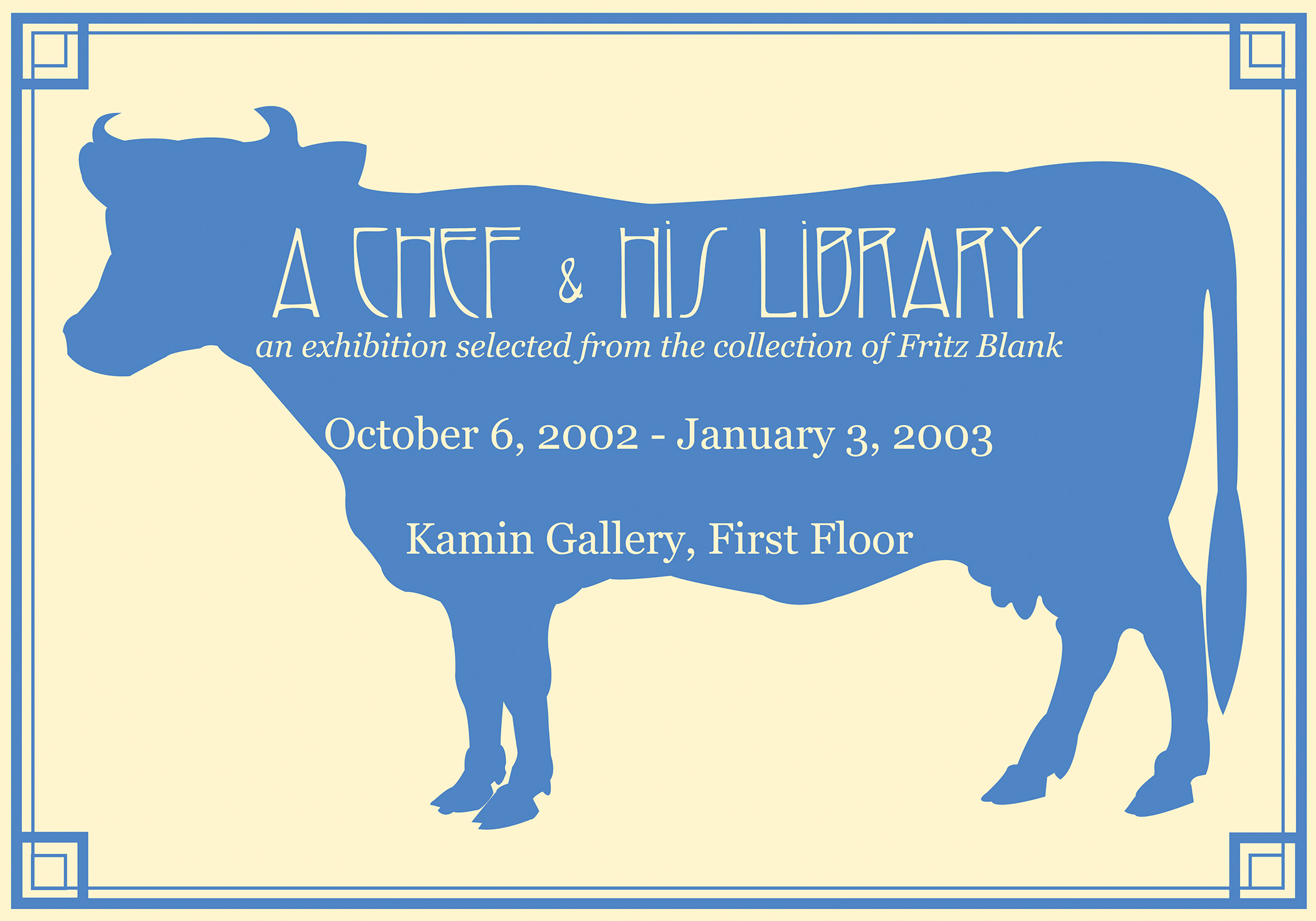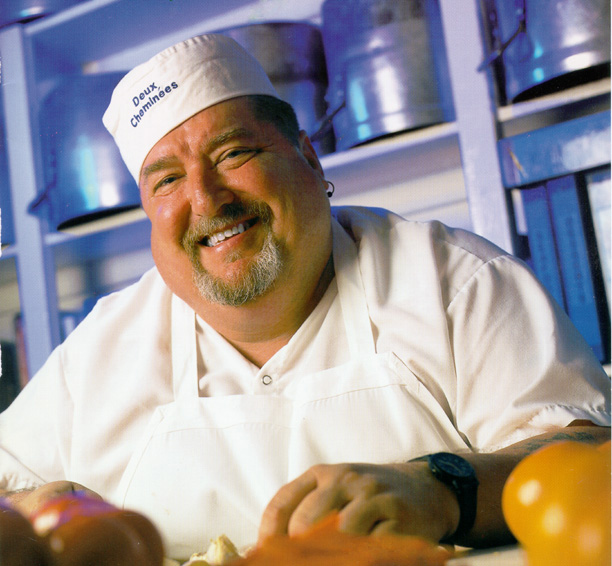
Chef Fritz Blank's culinary library helps to illustrate how a homegrown Jersey boy became one of America's foremost French chefs. After surviving a 1987 dumpster fire that otherwise gutted Blank's restaurant, Deux Cheminées, at its original location, his collection grew to over 10,000 volumes of cookery books plus recipe pamphlets, menus and other culinary ephemera. "A Chef & His Library" examines a paper trail of the influences—from his grandmother's cooking lessons to his career as a clinical microbiologist—that shaped Blank's culinary education and sensibilities.


Through Chef Fritz Blank’s anecdotes and stories about how he became Chef Fritz, I settled on recurring themes—the Army, music, German and Austrian cooking, the strong personalities that fed his developing taste for cookery, his love of camaraderie and more—to guide the sections of A Chef & His Library. These particular books deal with his life, his passions and most especially his education as a chef.
The materials are part of a working library, though some important books are missing. Shirley Corriher’s Cookwise for instance, is not included because it sits among two dozen dog-eared books on a Deux Cheminées’ kitchen shelf for all the staff to use.
A specific book such as the American Woman’s Cook Book contains recipes Blank explored and tested as a young boy. Others present variations of recipes that Blank subsequently modified and integrated into his 21st-century kitchen. Some are memory aids for people and times long gone. All are treasures of Fritz Blank.
Matthew Rowley
Curator
October 6, 2002

While I sometimes thought of A Chef & His Library as my own exhibit, it bears the imprint of many others, chief of whom is Chef Fritz Blank, who gave me unfettered access to his library. His insight, generosity, and hospitality broadened not only my knowledge, but my girth as well. Except where explicitly noted, all the materials in this exhibit are drawn from Chef Blank’s personal library.
My colleague Michael Ryan, Director of the Annenberg Rare Books and Manuscript Library at the University of Pennsylvania bears the onus of allowing me to mount this exhibit. He redeemed himself by offering help at every turn and for introducing me to his colleague Ellen DeMarinis, an immeasurable help in preparing this exhibit. The support and technical assistance of Greg Bear and Andrea Gottschalk at Penn finally brought A Chef & His Library to fruition.
Special thanks goes to the late Phyllis Bray Bober of Bryn Mawr College. Professor Bober’s insightful reading and input framed my understanding of Vittorio Lancellotti and curbed my blazing penchant for wordplay. At the Culinary Archives and Museum of Johnson and Wales University, Barbara Kuck’s unstinting support was a great help. Thanks also to Susan Drinan and Jeffrey Ray of the Atwater Kent Museum, to Barbara Ketcham Wheaton of Radcliffe College, to Jane Pap at Please Touch Museum and to Ronni Lundy for their input, inspiration and clarifications.
The founders of Stichting Gastronomische Bibliotheek in Amsterdam—Johannes van Dam, Joop Witteveen and Bart Cuperus—tolerated all my charcuterie and book-collecting inquiries in good humor. Over the course of the September 11th tragedies, they fed me well in Amsterdam and opened their homes and combined monumental cookbook collection to me, forever shattering a reputation the Dutch hold for aloofness.
The collected and contradictory wisdom about cookbook collectors from their dealers—Daniel Longone, Dirk Meuleman, Matt Sartwell, Bonnie Slotnick and Nach Waxman—was enlightening and amusing.
I must also extend a special thanks to the kitchen and wait staff of Deux Cheminées restaurant who suffered my presence for months before, one by one, beginning to ask “just what the hell are you doing here?”
And, finally, heartfelt thanks to Timothy “Hans” Furnish, who knew all along what I was doing.
Matthew B. Rowley
Curator
June 5, 2002
A Chef’s Curator
Matthew Rowley, MHA, lives and writes in Philadelphia. He sits on the board of the Southern Foodways Alliance at the University of Mississippi’s Center for the Study of Southern Culture and had been known to polish off an entire platter of Arthur Bryant’s beef & fries with extra burnt ends in one sitting.

Green & Gold Horizons, Winter/Spring 2002.
© Jerry Millevoi
From Silage to Salad
Chef Fritz Blank was born and reared in rural south Jersey among victory gardens, chicken coops and duck pens. Fresh seafood and small game such as rabbit and muskrat were a regular part of family meals prepared by his German grandmother. Her kitchen influences are some of Blank's earliest memories and continue to shape his cooking today at his Philadelphia restaurant Deux Cheminées.
Before becoming a chef, Blank earned degrees in dairy husbandry, dairy science, medical technology and clinical microbiology. He worked as an analytical chemist at the USDA Agricultural Research Center at Beltsville Maryland until accepting a commission in the US Army Medical Service Corps where Captain Blank functioned as a Clinical Laboratory Officer for five years. After leaving the military, Blank earned and completed a Masters degree in Clinical Microbiology at Thomas Jefferson University, and was the Associate Microbiologist at The Wilmington Medical Center. He later functioned for five years as Chief Microbiologist at Crozer-Chester Medical and Regional Burn Center, until opening Deux Cheminées in 1979.
Chef Blank is a frequent contributor to the Oxford (UK) Symposium on Food & Cookery and to the annual International Workshop on Molecular and Physical Gastronomy in Erice, Sicily. While Blank no longer makes silage, cows keep a special place in his heart and form a continuing decorative motif in his culinary library of over 10,000 volumes.
A Chef & His Library
Someone's in the Kitchen with Fritz
Standing in the Stockpots of Giants
Great Composers
Victus Populi
A Fine Mess
My Dear Heinrich
Cattail City
May I Take Your Menu?
Guten Appetit